Lighting is a very important element in wayang kulit (shadow puppetry). The use of modern lighting effects in wayang sometimes can actually weaken the appearance of the puppets because they are overshadowed by the glitter. The identity of Balinese wayang, with its aesthetic and symbolic values, demands lighting of a high capacity to illuminate, according to the form of the puppets, in a heightened style, creating a dramatic atmosphere via scenery or background in order to accommodate the shift in contemporary puppet audiences who tend toward realism.
I Ketut Sudiana is a lecturer in the padalangan (puppetry) Department at Institut Seni Indonesia (ISI, Indonesian Institute of the Arts) in Denpasar, Bali. He learned traditional wayang performance and puppet making in Sukawati with his father, Dalang I Wayan Nartha, and won the child dalang (puppeteer) competition in 1983. He studied at ISI for his undergraduate and graduate degrees and has toured to Taiwan, Hawai’i, Singapore, and Guam. This article was published in an earlier version in Indonesian (Sudiana 2022).
Introduction
The use of modern technology in Balinese wayang performance has been accepted as an improvement by audiences. Electric lights have long replaced the damar (coconut oil lamp) in projecting shadows and, as Winanti (2015, 16) has noted, the new effects appeal to audiences, especially young people who appreciate electric lighting or projectors as a sophisticated technology displaying colorful effects and adding visual interest. We see current dalangs (puppeteers) use effects such as strobe lights to support an atmosphere of chaos or for sparks that come from colliding arrows striking one against the other.
The displacement of the traditional damar (oil lamp) has been accepted by today’s dalang. However, the shadow effect caused by the coconut oil lamp is different from that of the electric light, and the oil lamp remains related to the crafting of traditional puppet figures rather than figures displayed through modern technology. Traditional puppets functioned aesthetically in relation to the wavering flame used until the 1970s: the traditional projection media suited the figures and was seen as representing the sun as a force of nature and source of life. For example, in the Dharma Pawayangan (Book of the Puppeteer) manuscripts the puppet master has formulas (rajah) that he contemplates at the top of the play or while studying that describe the function of the lamp along with other parts of his apparatus in a macrocosmic way:
The Screen functions as the Sky,
The lamp functions as the Sun
The vertical support [of the stage) as the bones,
The wick (?) functions as the sinews;
The banana trunk functions as the Earth. . . .
Formula of the lamp: OM Trimandala [Three mandala] . . . amirta [ambrosia] gives essence, the One God penetrates me . . .
(Hooykaas 1973, 77)[1]
Another of the puppeteer’s formulas dealing with the lamp is:
Ah IH God(dess) of the Night permit me to borrow the night; the Enlightened Dalang fixes the light to make the ringgit dance/move while he sings various melodies. Whoever listens to the sound of my voice, may he immediately fall in love, love, love. (Hooykaas 1973, 35)
Such formulas are of course related to traditional belief of white magic empowerment of the puppeteer and the performance through mantra and visualizations that make a puppet show ideologically equivalent to the forces of the universe. The presence of an actual flame brought an elemental feeling to moments of lighting the lamp or first bringing the figures onto the stage. For example, after a first dance of the tree of life puppet (kayonan), the specific characters to be used in the individual performance will be planted in the banana log, which represents earth, with the figures’ back edge to the screen, the positive characters to the right and the negative characters to the left. Then the dalang would push the damar gently so their shadows would begin to waver and shift. This represented the divine power of the cosmos breathing life into humanity, creating the earth as we know it. However, such moments of first displaying the figures and endowing them with breath by swinging the lamp look and feel quite different when a flickering flame is no longer the light source.
Thus, if the lighting changes, this greatly influences the wayang’s potential rules and aesthetics. This paper considers some issues arising from the combination of traditional Balinese wayang with electric lighting and ponders how to harmonize projectors with the traditional form.
Effect of Balinese Lighting and the Figures
Puppet bodies can be divided into three parts, as shown below (Figures 1-3):
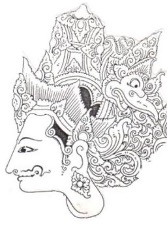
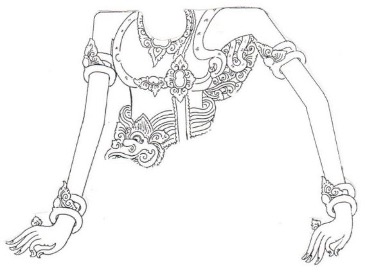
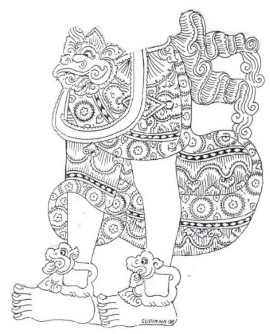
As a puppet practitioner, I realize that the results of the shadow puppet figures on the screen have been calculated by traditional shadow casters in order to produce an ideal shadow that matches the proportions of the human body and its stance, but this only works when the damar is the light source. The form of the wayang figures deviates from the proportions of normal humans because of the way the flame casts a figure’s shadow on the screen. The ratio between the head and the rest of a human body is 1: 6-7, but in Balinese wayang puppet figures the ratio is 1: 4. Hence, the puppet’s head and facial characteristics appear to be oversized. The puppet is not based on reality, but based on the shadow to be achieved. In Bali, shadow puppet shows are traditionally watched from the shadow side, with the lighting source from coconut oil damar. The shadow is the result of the puppet movement technique that has the face of the puppet firmly pressed onto the surface of the screen while the lower body and feet are away at a distance between fifteen to twenty centimeters from the screen surface. This positioning of the puppet on the banana log produces shadows more in accordance with the natural proportions of the human body. When needed, a figure can be brought closer to the screen and made to look shorter, allowing the puppet to appear compact, as if in a sitting position. Hence, manipulation concerns itself with the shadow side and not what the dalang and the figure are actually doing on the lamp side of the screen. The resultant shadow on the audience side is the only thing that approximates the height and width of a real human body. Other anthropometric measures are, likewise, part of the manipulation technique and they affect the transformation of the shadow to approximate the human body, but only when the puppet is projected on the screen. Let us examine a figure from head/headdress to toe.
The wayang figure below illuminated with two different types of media, the traditional damar and today’s electric light, will produce the shadows seen in the pictures below (Figures 4 and 5).
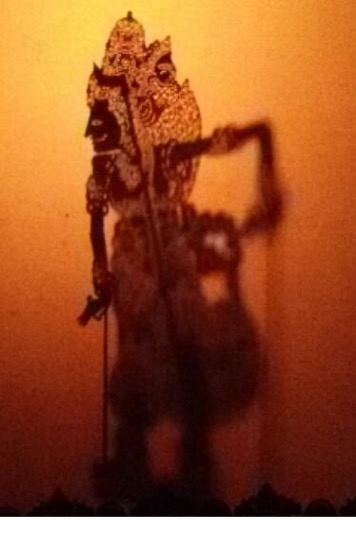
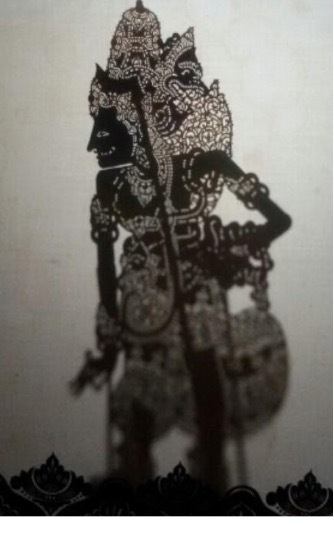
The illumination of the lamp, with its flame, produces the illusion of height, so that the puppet figure is closer to an ideal. The damar produces shadows with the proportion of the head to the overall body of 1: 6.5, while electric lights produce a proportion of 1: 5. This shows that the wayang tradition, its figures, and performance techniques, have developed in relation to the coconut oil lamp. Thus, if one is using electric lighting on the puppets, the figures need to be made in accordance with the intended results that will be achieved by the electric lighting. This applies to the various types of electric lights, such as LEDs (light emitting diodes), halogens, LCDs (liquid crystal display), and other types of electrical lighting.[2]
Scenery in Traditional Wayang
In the traditional wayang kulit performance, the dalang uses the kayonan (tree of life, also called kayon) puppet to create the atmosphere for scenes that depict a particular place: a palace gate, a tree, or other elements.[3] What is more, the kayonan has additional important meanings in wayang kulit performances as something that can represent everything—the universe and all its contents. The kayonan dance at the opening of a puppet show conveys the philosophical meaning of the creation of the universe. The puppeteer who animates the kayonan starts by chanting the mantra of the unification of the nine directions (eight compass points and the center). The mantra for each dalang who starts a show follows a clockwise progression, naming the various deities/powers associated with each point, saying:
Om idepakne Sambhu mulih (ma)ring Wisnu; Wisnu mulih ring Sangkara; Sangkara mulih ring Mahadewa, Mahadewa mulih ring Rudra; Rudra mulih ring Brahma; Brahma mulih ring Maheswara: Maheswara mulih ring Iswara; Iswara mulih ring kayonan; kayonan mulih maring manah sakti mahening (Sedana 2016, 37).
Sambhu takes the place of Visnu [Wisnu], V. [Wisnu] that of Sangkara, Sangkara takes the place of Mahadev[/w]a, M. [Mahadewa] that of Rudra, Rudra takes the place of Brahma, B. [Brahma] that of Mahesv[/w]ara, Mahesv[/w]ara takes the place of Isv[/w]ara, I. [Iswara] that of the Kayon, the Kayon take the place of the Pure All-Powerful Mind … (Hooykaas 1973, 33)
As mentioned earlier, what this opening refers to and what is also part of the kayonan iconography is the cosmos as represented by the different deities, which represent the compass points, their quadrants, and the center. The power of everything is returned to its divine source as represented by the kayonan.The five branches on the bottom of the figure are also meant to represent the unification of five natural elements, which in Balinese Hindu ideology are called the Panca Maha Buta; pertiwi (earth), apah (water), bayu (wind/air), teja (light/fire), and akasa (sky).
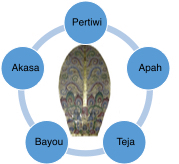
Starting from the kayonan philosophy in wayang performances, the kayonan can function or be played as pertiwi (earth—land, mountain, or hill), apah (water—ocean, lake, pond, well, river, sea), teja (light—sun, star, fire, moon), bayu (air, wind), and akasa (sky, clouds, space). In addition to functioning as the opening and closing of the performances, the kayonan becomes scenery. For example, the kayonan is used to create the atmosphere of rain, a tornado, rays beaming from the gods and descending from the sky, and ocean depths through which the puppet figures may dive. Different kinds of manipulation of the puppet as it flutters, twirls, or is held stationary can give these different effects.
There are many other meanings and uses of kayonan depending on the position or function the dalang needs, and the motion that is created by the puppet master. The function and meaning of the kayonan supporting and creating the atmosphere of the scene in wayang kulit is an accepted agreement of aesthetic expression between the audience and the dalang. This gives this important shadow figure a multi-functional meaning in the performance. As scenery, it does not have to appear like the actual element of nature, or a building, or a set piece for which it stands, but its effect on the audience’s emotions is very strong. In contemporary wayang, however, we see the development of scenery shown more realistically: a gate will look like an actual Balinese temple gate; a tree will be like a real tree. Is the aesthetic impact of the art thereby lessened?
Kenneth Gross’ interview with Dalang I Made Sidja notes some of the magic of the kayonan and the kind of critique that his generation may have for younger puppeteers’ innovations:
The dalang will at times pull the rotating kayon so far back from the screen that all you see is the vaguest and lightest of shadows pulsing on the white surface. I Made Sidja told me that this puppet “symbolizes the movement of human beings, fixed, cloudy, unpredictable, straying, steady, clear and unclear” as well as the power of the puppeteer himself. . . . [Sidja] told me that the kayon is also the dalang’s passion, his heart. It was for this that he spoke with contempt of some of the more innovative dalangs who use two or three kayon at once, chiefly as elements of visual display.” The kayon is your heart, you have only one heart, and you use it even if it is broken.” (Gross 2011, 131)
These more realistic representations of the world as we know it have become commonplace in the work of younger dalangs trained at the Institut Seni Indonesia (Indonesian Institute of the Arts) in Denpasar, Bali. But their more naturalistic representation of the world may lessen the mythic dimension that use of the kayonan, with its many manifestations allows, when realism reigns.
Scenery Lighting Creativity in Innovation Puppet Shows
Wayang kulit in Bali is influenced by globalization in the form of technological advancements, especially regarding lighting. Many dalangs have replaced the traditional lighting created by the flame from coconut oil in an effort to “innovate” wayang performances that adapt to our era. When puppets are illuminated with modern lighting sources, new ideas emerge and the dalang chooses to display images on the screen via more realistic scenery. Scenery is made with paper which is drawn on clear plastic in a rectangular shape and framed to make surroundings of the scene. This newer style of scenery is projected onto the screen with a halogen lamp so that, on the screen, the scenery appears in accordance with the expected background, be it a temple or forest.
The purpose of this more realistic scenery is the same as in the traditional wayang where the kayonan might be used as a support for every scene. Scenery is replaced according to the needs of the desired atmosphere, and changed from setting one (for example, a palace court) to setting two (say, a scene set in nature), and so on. Thus, there are at least two or more sets of scenery and electric light sources to project them, so the setting can be displayed alternately, and, thereby, change from scene to scene. But, as I have observed, these more realistic images that are projected are often not adjusted to the wayang tradition—nor do they acknowledge the traditional proportions mentioned earlier of how the figure’s face must be placed closer to the screen. Institut Seni Indonesia dalang, I Made Sidia, in his experimental works, often uses scenery in accordance with nature, using as inspiration photographs of arches, forests and mountains, the sea, etc., as the background of his shows.[4] This use of scenery was innovated by Larry Reed, an American puppet artist of ShadowLight theatre, in his work Reed termed electric puppetry (wayang listrik).[5] However, the result of emulating an actual tree or porch is often a realistic form, even though it is made with paper carved into the determined shape. At first glance it looks beautiful, but sometimes it appears unbalanced with the wayang aesthetic. Dalang Cenk Blonk, who is very popular in Bali, also uses panoramas on this model.[6]
This type of scenery is used by Dalang I Wayan Wija in his 2016 multi-puppeteered (animated by four children) production of the story Rare Angon (Figure 6).[7] Scenery was mounted on two dowels and changed by turning the pole on which the settings have been mounted. Each pole of scenery contains five panels (preset scenic displays) rotated to the need of the desired scene. In Bali, this is called swivel scenery (Figure 6).
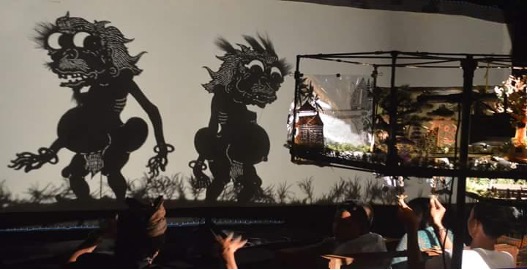
Technology in wayang puppetry is increasingly advancing with the existence of LCD (Laser Compact Disc), and the puppet creators are starting to make backgrounds with panoramic images that are very realistic. Essentially, to my mind, all of the experiments that have been carried out, cultivating these realistic backgrounds, have not been worked out in full. A solution to creating harmony between the main objects (puppet characters), which have been conceived with stylization suitable to the manipulation technique which presses the head to the screen to achieve proportions, and the realistic scenery is still in process. Even if this switch to including realistic scenery occurs more generally, the process of making puppets that are equally detailed has not yet been attempted. The call of elder dalangs to follow tradition in a form that has, in certain performances, ritual power may be one element that has led to the disconnect. And to make new sets of wayang figures is an expensive commitment; puppets are often inherited from parents or borrowed from teachers when a young dalang begins to perform. To make a new set of wayangs requires considerable cost and effort. As a teacher of puppet making at ISI, I am tackling this issue in my classes and in my own crafting. There is no lack of ability to create elaborate scenery. But, up to the present, the creators are not spending the same amount of time and artistic effort to make scenery that has been invested in the process and craft and aesthetics of making puppets, which remain with their original design and are better suited to the non-realistic use of the kayonan as an all-purpose and more metaphorical scenic choice.
Conclusion
I conducted an experiment to address the problem of proportion and sharpness of image in wayang aesthetics when using electric lights, producing a wayang figure (see Figure 7) beside a traditional wayang (see Figure 8).
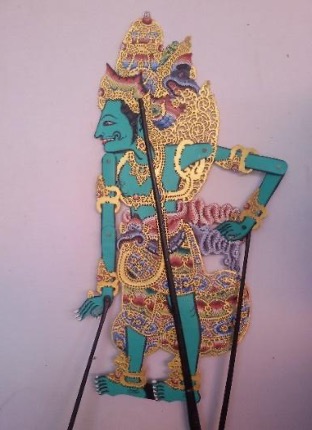
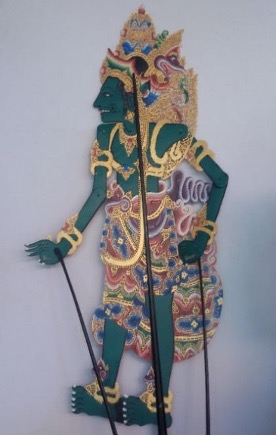
I created a puppet of Kresna with the proportions and complexity of design that might be compatible with the kind of realistic stage sets and scenery now being used. I kept the iconography of the clothing and jewelry as customarily worn, but altered the head size (making it smaller), increased the height, and diminished the width of the figure. The combination of a revised wayang human figure and realistic scenery is therefore in harmony. The puppet is taller (proportionally) and detailed. A full set of such figures would need to be made to carry my experiment to completion.
In this article, I have also shared some of the images of scenery models I have created and the results of an experiment modification using image processing and video editing techniques, such as Adobe Premiere with various options such as Adobe Premiere Pro, that can be used to edit videos, combine videos with music, change colors, etc. (see Figures 9 and 10).

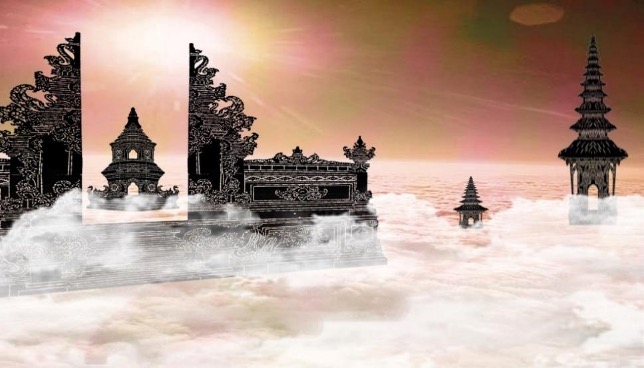
I offer new alternatives in adapting traditional art to meet modern technology without eliminating the essence of wayang that concerns ethical, aesthetic, and philosophical values.[8] With today’s fast-paced technological developments, wayang must continue to develop. Therefore, dalangs are required to advance with their performance, always prioritizing aesthetic values and responding to the demands of the audience. Through quality work supported by technology, new wayang can be artfully explored without destroying this heritage art and ¥we can counteract any negative influences arising from the modernization process.
[1] Translations of Hooykaas (1973) here do not include his use of diacritics and the numbers he inserts in his translation to allow readers to compare sentences with the Balinese original.
[2] LED (light-emitting diode) lights use semiconductors to create light. Halogen lamps use a filament heated by an electric current. LCD means liquid crystal display. Liquid crystals need a reflector to produce images and LCDs usually use fluorescent lights.
[3] For some background on the kayonan see Long (1985), Foley (1987), and Foley and Smith (2015).
[4] See Pupperoos (2011) and Sidia (2017) for examples of I Made Sidia’s work.
[5] See https://www.shadowlight.org/wayang-listik, accessed 19 May 2023, for Reed’s website. Articles discussing his work include Cohen (2007), Ehrlich (2010), Foley (2011), and Willis (2013).
[6]Examples are on Cenk Blonk’s YouTube channel, for example https://www.youtube.com/watch?v=lRTCxC8cNnw, accessed 19 May 2023. For more information on Cenk Blonk see Foley (2012a), Jenkins (2010), and Winanti (2015).
[7] On Wija see Chu (2011), Foley (2012b), and Gold (n.d.)
[8] See also Sudiana (2005).
References
Cohen, Matthew Isaac. 2007. “Contemporary Wayang in Global Contexts.” Asian Theatre Journal. 24, No. 2: 338-369. https://www.researchgate.net/publication/236820567_Contemporary_Wayang_in_Global_Contexts, accessed 5 July 2023.
Chu, Jenny.2011. Bali: Shadow Puppets – I Wayan Wija. Asian Art Museum, SF https://vimeo.com/30008012, accessed 19 May 2023.
Ehrlich, Linda C. 2010. “ShadowLight Productions: Explorations of the Shadow World.” Asian Cinema 21, No. 2: 315-18. DOI: https://doi.org/10.1386/ac.21.2.315_4, accessed 19 May 2023.
Foley, Kathy. 2011. “Shakespeare-Asian Theatre Fusions: Globe-“alization” of Naked Masks (Bangkok), ShadowLight (San Francisco), and Setagaya Public Theatre (Tokyo).” Asian Theatre Journal 28, No. 1: 7-43. https://www.jstor.org/stable/41306469, accessed 30 July 2023.
_____. 1987. “The Tree of Life In Transition: Images of Resource Management in Indonesian Theatre.” Crossroads: An Interdisciplinary Journal of Southeast Asian Studies 3, no. 2/3 (1987): 66–77. http://www.jstor.org/stable/40860244, accessed 19 May 2023.
_____. 2012a. “Cenk Blonk.” World Encyclopedia of Puppetry Arts. https://wepa.unima.org/en/cenk-blonk, accessed 19 May 2023.
____. 2012b. “I Wayan Wija.” World Encyclopedia of Puppetry Art. https://wepa.unima.org/en/i-wayan-wija/, accessed 19 May 2023.
_____, and Karen Smith. 2015.“ Kayon/Gunungan: Tree of Life/Cosmic Mountain.” Puppetry International 38: 4-6. https://static1.squarespace.com/static/55a7e9aee4b02395231deded/t/5e8b8778fa0b1d1af99e1df4/1586202510785/38-PI+FALL-WINTER+2015.pdf, accessed 22 May 2023.
Gold, Lisa. [n.d.] “Musical Knowledge, Innovation, and Transmission Within the Ecosystem of Balinese Wayang Performance.” Smithsonian National Museum of Asian Art. https://asia-archive.si.edu/essays/article-gold/, accessed 5 July 2023.
Gross, Kenneth. 2011. Puppet: An Essay on Uncanny Life. Chicago and London: University of Chicago Press.
Hooykaas, Christiaan. 1973. Kāma and Käla: Materials for the Study of Shadow Theatre in Bali. Amsterdam: North Holland Publishing.
Jenkins, Ron. 2010. Rua Bineda in Bali: Counterfeit Justice in the Trial of Nyoman Gunarsa. Yogjakarta: Institut Seni Indonesia [(ISI)].
Long, Roger. 1985. “People and Nature in Javanese Shadow Plays.” In Cultural Values and Human Ecology in Southeast Asia, ed. Karl L. Hutterer, A. Terry Rambo, and George Lovelace, 195-204. University of Michigan Press. http://www.jstor.org/stable/10.3998/mpub.19463.11, accessed 19 May 2023.
Pupperoos. 2011. “I Made Sidia Masterclass: Balinese Wayang Shadow Puppetry.” https://www.youtube.com/watch?v=xJEDV0fWABE, accessed 19 May 2023.
Sedana, I Nyoman. 2016. “Teori Cipta Seni Konseptual” (Theory of Creating Conceptual Art). Prosiding Seminar Nasional, Seni Pertunjukan Berbasis Kearifan Lokal (Proceedings of National Seminar of Performing Arts and the Basis of Local Wisdom), ed. by I Nyoman Sedana, 34-47 [FSP]: Denpasar.
Sidia, I Made. 2017. “Balinese Shadow Puppet Theater with a Twist/I Made Sidia.” TEDxUbud, 22 August. https://www.youtube.com/watch?v=SJ2L-CsSylg, accessed 19 May 2023.
Sudiana, I Ketut. 2005. Materi Panduan Praktek Pembuatan Wayang Kulit Parwa Bali (Guide to the Practice of Making Balinese Parwa Shadow Puppets). Jakarta: Proyek Nasional Pelindungan Wayang Indonesia (National Project for Protection of Indonesia Puppetry).
_____. 2022. “Kreativitas Tata Cahaya Wayang Kulit Bali Masa Kini” (Creativity in Contemporary Wayang Kulit Bali Lighting). Jurnal Syntax Fusion: Jurnal Nasional Indonesia (Syntax Fusion Journal: Indonesian National Journal) 2, No. 12, https://fusion.rifainstitute.com/index.php/fusion/article/view/227, accessed 5 July 2023.
UNESCO Video and Sound collection. “Pembuatan: Wayang Kulit Parwa Bali” (Shadow Puppet Making) [Indonesian]. https://www.unesco.org/archives/multimedia/document-4174?TSPD_101_R0=080713870fab2000065393b093c81eba42d3afee3524a68a95bee856dd4ab730dce780e2170171a508aa8a4a0e1430007c2c22f1d8dff1bdd9ba2adbf94c1fc28210768735727e1178588e25cde303346bc00bcbe335ef9f5771669e33cb10d3, accessed 19 May 2023.
Winanti, Ni Putu. 2015. Cenk Blonk Dalang Inovatif (Cenk Blonk, Innovative Puppet Master). Surabaya: Paramita. Willis, Sachikio. 2013.
“Larry Reed.” World Encyclopedia of Puppetry Arts, ed. Karen Smith. https://wepa.unima.org/en/larry-reed/, accessed 19 May 2023.

